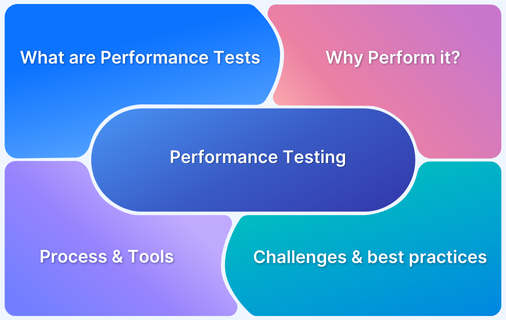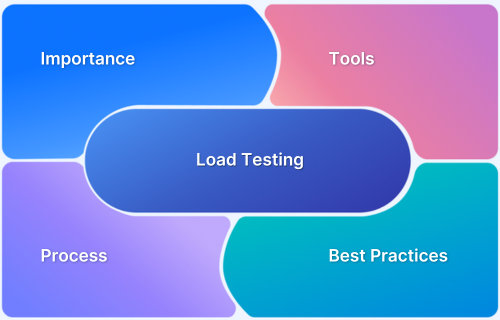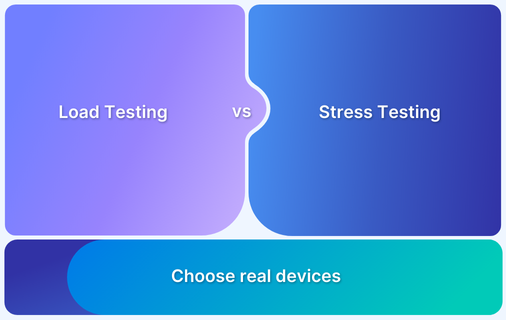Modern applications are developed to handle multiple threads or processes executing simultaneously to improve performance and responsiveness.
Overview
What is Concurrency Testing?
Concurrency testing tests the stability of software applications that execute multiple threads or processes simultaneously.
Importance of Concurrency Testing
Concurrency testing ensures software performs reliably under simultaneous user or process load. It helps identify scalability limits, prevent bottlenecks, and optimize resource usage effectively.
Top Tools for Concurrency Testing
- Apache JMeter: Simulates user load to test web app performance.
- Gatling: Scala-based tool for high-performance HTTP load testing.
- Locust: Python tool for writing and running concurrent user tests.
- Taurus: Integrates with other tools for easy test automation.
- BlazeMeter: Cloud platform for scalable, open-source load testing.
This article dives into the benefits, methodologies, tools, and best practices of concurrency testing, helping developers create more robust and reliable applications.
What is Concurrency Testing?
Concurrency Test is a performance testing procedure that tests multiple users on the same server. It tests how well a software can handle multiple concurrent users or processes using it simultaneously while performing the same actions.
Concurrency testing is also known as multi-user testing.
It ensures the system can handle concurrent requests without crashing or causing data corruption. This type of testing verifies the system’s performance when various software components execute concurrently.
Key scenarios tested in Concurrency Testing include:
- Simultaneous background or cron jobs running with user requests
- Microservices managing multiple simultaneous requests
- Cache invalidation across different servers
- Asynchronous communication in distributed systems
- Multiple users updating the same record at the same time
Benefits of Concurrency Testing
Here are the key reasons why concurrency testing is important:
- A successful concurrency test validates the software’s ability to handle concurrent users or processes. It gives developers insights into the system’s ability to scale, limitations, and requirements. Developers can then scale the infrastructure or optimize the code to accommodate expected load increases.
- A successful concurrency test validates the software’s ability to handle concurrent users or processes. This provides insights into how reliable the system can be when under stress.
- Concurrency testing helps development teams save costs. It helps to prevent downtime and the associated costs and risks.
- Concurrency testing provides insights into how system resources are used, helping allocate resources efficiently.
What is Concurrent User Testing?
Concurrent users are the number of users who are actively interacting with a website or application at the same time. These users might be browsing, making purchases, filling out forms, or performing any other activity on the software.
Concurrent user testing simulates multiple users interacting with an application simultaneously. Testing with concurrent users evaluates the system’s ability to handle a steady or expected workload over time.
It simulates real-world user actions at varying times to evaluate system performance, scalability, and resource usage. It helps uncover issues like locking, deadlocks, and thread-related bugs, ensuring the application remains stable and responsive under normal and peak loads.
Also Read: Guide to UI Performance Testing
What is Load Test for Concurrent Users?
Load testing for concurrent users involves simulating multiple users accessing a system simultaneously to measure its performance under load. Web applications must ensure stability during peak usage.
The goal is to observe system behavior as simultaneous users execute tasks, helping uncover performance issues before they impact real users.
In this context, concurrent users interact with the system in real time, sending requests, using resources, and expecting fast responses.
Key objectives of load testing for concurrent users include:
- Measuring system capacity before performance degrades
- Monitoring response time, throughput, and error rates at different user loads
Identifying bottlenecks early for better optimization
Common Concurrent User Load Testing Scenarios
Concurrent user load testing is essential for ensuring a system can handle multiple users interacting simultaneously without degradation in performance.
Also Read: How to Test an E-commerce Website
Here are some common scenarios:
- E-commerce Platform During Sales Events: Testing ensures the platform can handle thousands of users browsing, adding items to carts, and checking out simultaneously without crashing or delays.
- University Registration System: Load testing helps ensure the registration system can process multiple logins, course selections, and payments without significant slowdowns during peak usage times.
- Streaming Service Launch: This testing ensures that a streaming platform can handle millions of viewers logging in and streaming content simultaneously, maintaining a smooth and uninterrupted viewing experience.
The Importance of Concurrent Load Testing
Here are the key benefits of Concurrent Load testing:
- Concurrent load testing helps spot potential performance issues before they affect users.
- Testing ensures the application can handle peak usage without slowing down or crashing.
- You test the system’s ability to withstand heavy traffic by replicating multiple users.
- Consistent performance during high-traffic periods is crucial for maintaining customer satisfaction.
- Slowdowns or downtime can drive users away, making load testing essential to avoid such issues.
- Regular testing ensures the system remains reliable, even during the busiest times.
When to Perform Concurrent Testing
Concurrent testing ensures software remains reliable, responsive, and efficient during simultaneous user activities.
Below are scenarios when Concurrent Testing can be performed:
- Concurrency testing is essential when assessing how a system performs under heavy load, with many users accessing it simultaneously.
- In distributed systems, concurrency testing verifies that different components communicate and interact correctly, even when requests are handled in parallel.
- When a system has background tasks alongside user requests, concurrency testing ensures they don’t interfere with user operations or cause performance problems.
- In microservices architectures, where different services interact concurrently, concurrency testing verifies that these interactions are handled correctly.
- Web applications that handle many users simultaneously benefit from concurrency testing to ensure stability and performance.
- As part of regular performance tuning and during system upgrades or migrations
How to Perform Concurrent Testing
Here is a step-by-step guide on how to perform concurrency testing:
- Define test scenarios and identify concurrency-prone areas like database access, logins, or resource-heavy operations.
- Establish realistic concurrency patterns and performance goals based on expected user behavior and system capacity.
- Design targeted test cases covering various user roles, actions, and data usage patterns.
- Select appropriate tools for concurrency simulation, profiling, and system monitoring (e.g., BlazeMeter, JProfiler).
- Run tests incrementally by gradually increasing the number of concurrent users.
- Monitor key system metrics such as response time, error rate, CPU/memory usage, and DB performance.
- Analyze results and refine test cases or configurations to address bottlenecks and inefficiencies.
- Resolve concurrency issues by optimizing code, scaling infrastructure, and improving database performance.
- Implement caching where needed to reduce load and improve speed.
- Document findings and share results with stakeholders for resolution and future improvements.
Top Tools for Concurrent Testing
Here are some top tools for concurrent testing:
- Apache JMeter: Open-source tool for simulating multiple users and measuring system performance under load; ideal for web apps.
- Gatling: High-performance load testing tool with a Scala-based scripting language; great for testing HTTP servers.
- Locust: Python-based tool for writing user scenarios as code and performing distributed, concurrent testing easily.
- Taurus: Automation-friendly framework that integrates with JMeter, Locust, and Gatling for streamlined concurrency testing.
- BlazeMeter: Cloud-based tool supporting open-source load testing tools with scalable concurrency testing and advanced monitoring.
Must Read: Top 20 Performance Testing Tools
Key Metrics to Monitor in Concurrency Testing
The key metrics to monitor in concurrency testing include the following:
- Concurrent Users: This metric, also known as the number of simultaneous users, is essential for understanding the system’s ability to handle multiple users simultaneously without performance issues.
- Latency: This represents the delay between a request and the system’s response. Low latency is crucial for a good user experience.
- Throughput: It measures the amount of work or transactions a system can handle per unit of time. High throughput indicates the system can handle a large number of requests efficiently.
- Error Rate: This is the percentage of failed requests or transactions, indicating the system’s stability and reliability. A high error rate suggests potential issues that need to be addressed.
- CPU and Memory Utilization: Monitoring these resource usage metrics helps identify if the system is overloaded or if there are bottlenecks in processing or memory access.
Test on Real Devices with BrowserStack
Running concurrency tests on real devices ensures accurate results by reflecting actual user conditions, including hardware, OS behavior, and network variability.
BrowserStack Automate offers access to 3500+ real devices and browsers, enabling comprehensive and reliable concurrency testing across diverse environments.
Key Benefits of testing on BrowserStack Automate:
- Real User Conditions: Tests replicate real-world usage using real device cloud, not emulators or simulators.
- Extensive Device Coverage: Supports thousands of real devices and browsers for wide testing scope.
- Cross Browser & Cross-Device Validation: Ensures consistent app performance across different platforms.
- Cloud-Based Testing: Eliminates setup time with on-demand access to devices from the cloud.
- CI/CD Integration: Works seamlessly with tools like Jenkins, GitHub, and others for automated workflows.
- Accurate Performance Metrics: Detects concurrency, responsiveness, and stability issues under real conditions.
Advantages of Concurrency Testing
By simulating the interaction of multiple users or processes at the same time, concurrency testing provides the following advantages:
- Valuable Insight: Concurrency testing gives insights into issues like locking, deadlocks, and flaws in single-threaded code
- Enhanced Scalability: It ensures applications remain stable, scalable, responsive, and free of crashes or errors
- Economic Impact: Conducting multiple tests simultaneously reduces the overall user testing cost by minimizing the time and resources required for scheduling, setup, and execution. This makes it a more economical choice for organizations with large-scale testing efforts. It also saves organizational costs due to downtime.
- Mimic Real-World: Concurrent testing can better simulate real-world conditions where multiple users interact with your system simultaneously. This is particularly valuable for applications that rely on social interaction, collaboration, or multi-user functionalities.
- Diverse Feedback: When various users interact with your system concurrently, you can observe a broader range of behaviors, preferences, and issues. This diversity helps identify common usability problems and better understand different user perspectives.
- Improved User Experience: A successful concurrency test means an improved user experience under load, as defects are detected early.
Disadvantages of Concurrency Testing
The key disadvantages of Concurrency Testing are as follows:
- Resource-intensive: Concurrent testing requires a significant amount of resources, including hardware, software, and personnel. This can be a disadvantage for organizations with limited resources.
- Increased Complexity: Concurrent testing involves running multiple tests simultaneously, making the testing process more complex and challenging to manage.
- Non-Deterministic Bug: Concurrency can lead to bugs that only appear under specific timing conditions, making them hard to reproduce and debug.
- Risks of Interference: Running multiple tests concurrently increases the risk of interference between different test cases. Interference can result in false positives or negatives, making it harder to assess the system’s quality accurately under test.
Best Practices for Concurrency Testing
Here are some best practices used for Concurrency Testing:
- Fuzz Testing: In this technique, the tester deliberately inserts random, incorrect data into the system to observe how it responds. This approach can help detect and identify potential vulnerabilities in the design, which can then be addressed and rectified.
- Random Testing: This method runs multiple threads simultaneously while randomizing the test inputs. This method can help detect race conditions and other issues that may arise when multiple lines access the same resources simultaneously.
- Code Review: This technique thoroughly scrutinizes the code and its structures to identify potential issues or weaknesses. This can help ensure the code is robust and reliable under high-load conditions.
Conclusion
Concurrency testing is essential for building robust, scalable, and resilient applications.
By using tools like JMeter, BlazeMeter, or Locust, and leveraging real-device testing through BrowserStack, teams can simulate complex scenarios, uncover hidden performance flaws, and deliver a seamless experience to their users, no matter the load.
By performing Concurrency Testing on a system, organizations can ensure their software performs flawlessly under real-world and varying load conditions.






